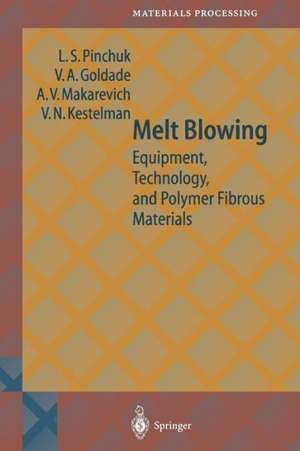Melt Blowing: Equipment, Technology, and Polymer Fibrous Materials: Springer Series in Materials Processing
Autor L.S. Pinchuk, Vi.A. Goldade, A.V. Makarevich, V.N. Kestelmanen Limba Engleză Paperback – 5 noi 2012
Preț: 384.31 lei
Nou
Puncte Express: 576
Preț estimativ în valută:
73.56€ • 76.50$ • 61.64£
73.56€ • 76.50$ • 61.64£
Carte tipărită la comandă
Livrare economică 13-27 martie
Preluare comenzi: 021 569.72.76
Specificații
ISBN-13: 9783642627859
ISBN-10: 3642627854
Pagini: 228
Ilustrații: XII, 212 p.
Dimensiuni: 155 x 235 x 12 mm
Greutate: 0.33 kg
Ediția:Softcover reprint of the original 1st ed. 2002
Editura: Springer Berlin, Heidelberg
Colecția Springer
Seria Springer Series in Materials Processing
Locul publicării:Berlin, Heidelberg, Germany
ISBN-10: 3642627854
Pagini: 228
Ilustrații: XII, 212 p.
Dimensiuni: 155 x 235 x 12 mm
Greutate: 0.33 kg
Ediția:Softcover reprint of the original 1st ed. 2002
Editura: Springer Berlin, Heidelberg
Colecția Springer
Seria Springer Series in Materials Processing
Locul publicării:Berlin, Heidelberg, Germany
Public țintă
ResearchCuprins
1. Introduction (Historical Review).- 2. Melt Blowing Techniques.- 2.1 Main Technological Procedures.- 2.2 Modern Trends in Melt mowing Techniques.- 3. Equipment.- 3.1 Spray Heads.- 3.2 Auxiliary Equipment.- 4. Structure of Melt-Blown Polymer Fibrous Materials (PFM).- 4.1 Major Structural Parameters.- 4.2 Effect of Different Technological Regimes on PFM Structure.- 5. Specific Properties of Melt-Blown PFM.- 5.1 Physicochemical Characteristics.- 5.2 Electret Charge in Melt-Blown Materials.- 6. Fibrous Materials in Filtration Systems.- 6.1 Efficiency of Filtration Systems.- 6.2 Filtration Mechanisms.- 7. Electret Filtering PFM.- 7.1 Mechanism of PFM Polarization.- 7.2 Capillary Phenomena.- 7.3 Production Process and Properties of Electret PFM.- 7.4 Applications.- 8. Magnetic Filtering PFM.- 8.1 Backgro.- 8.2 Simulation of Magnetic Deposition in PFM.- 8.3 Theory versus Experiment.- 8.4 Magnetization of PFM.- 8.5 Magnetic Coagulation of Particles in PFM.- 8.6 Magnetic Capillary Phenomena.- 8.7 Serviceability of Magnetic PFM-Based Filters.- 9. Adsorptive and Microbicidal PFM.- 9.1 PFM Modified by Porous Adsorbents.- 9.2 PFM as Adsorbents of Oil Product8.- 9.3 Complex-Forming PFM.- 9.4 Adsorptive-Microbicidal PFM.- 10. PFM as Carriers of Microorganisms.- 10.1 Biofilters with Polymer Fibrous Biomass Carriers.- 10.2 Effect of Magnetic Fields on the Growth Proce8ses of Microorganisms.- 11. Other Applications of PFM.- 11.1 Household Uses.- 11.2 Industry.- 11.3 Construction.- 11.4 Medicine.- 11.5 Packing.- 11.6 Protection of Products and Environment.- 12. Ecological and Social Problems.- 12.1 Solution of Ecological Problems.- 12.2 Regeneration, Utilization, and Burial.- 12.3 Economic Estimates.- 13. Conclusion.- References.
Textul de pe ultima copertă
This book is devoted to a nontraditional class of materials which are manufactured by the melt-blowing process - i.e. by extrusion of polymer melt followed by fiber stretching with a gas stream. For the first time extensive data on classical and modern modifications of this technology are generalized and a review is given of extrusion head dies and subsidiary equipment. The text examines the structure and main properties of melt-blown materials as conditioned by peculiarities of overheated polymer melt spraying in oxidizing medium. Information is given about filtering mechanisms and the main types of polymer fibrous filtering materials: electret, magnetic, adsorptional, bactericidic and about carriers of microorganisms in biofilters. Social and ecological aspects of the application of melt-blown materials are analyzed.
Caracteristici
This book introduces the basics of a new class of materials, expected to have wide-ranging applications in future, with important economic consequences













